Why It’s So Important that Cities Run Summer Youth Employment, Even During a Pandemic
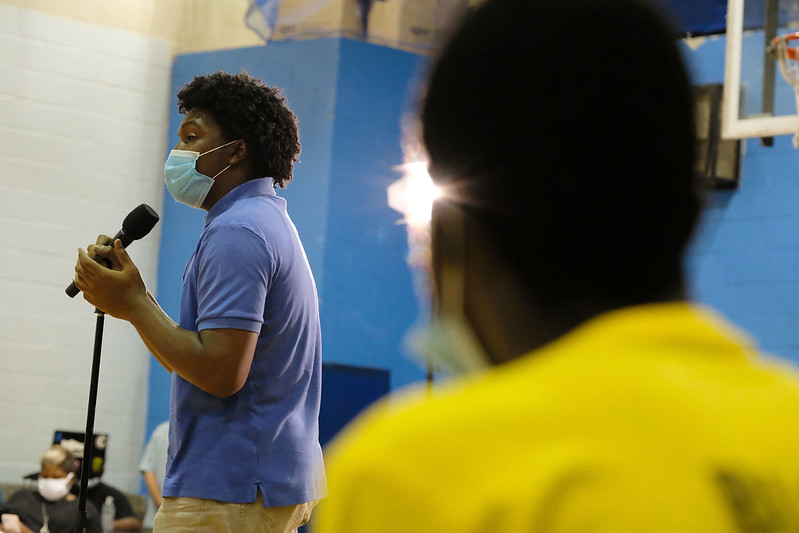
Students at a town hall (photo: Ed Reed/Mayor's Office)
Early work experience — such as that provided by summer jobs — can keep teens out of trouble, improve soft skills, and build strong pathways for their futures. Based on this belief, over the past several decades policymakers and business leaders have joined together to create summer youth employment programs across many U.S. cities. Generally, these programs provide youth age 14 to 24 the opportunity to work 20-25 hours per week for a six-week period from early July through mid-August and earn the minimum wage.
Yet the economic disruption caused by the COVID-19 pandemic placed summer jobs programs in jeopardy at the exact moment when they are needed the most. The unemployment rate for youth age 16 to 19 years nearly tripled from 11.0 percent in February to 31.9 percent in April, as many businesses that employ youth such as retail, eating, and drinking establishments were forced to shut down to reduce the spread of infection. At the same time, some cities initially canceled their summer jobs program—much to the dismay of youth and their advocates.
New York City, which typically employs upwards of 75,000 youth each year, recently reinstated its program after a grassroots movement led by youth pushed the mayor to restore funding and get more creative given social distancing protocoles.
Research clearly demonstrates that summer jobs programs develop skills among youth that lead to better long-term criminal justice, academic, and employment outcomes. Our multi-year evaluation in Boston funded by William T. Grant Foundation shows that summer jobs programs lead to significant boosts in community engagement, social skills, job readiness skills, work habits, and college aspirations that are linked to the long-term improvements in crime, school, and employment outcomes. And it’s not just Boston—studies conducted in Boston, Chicago, and New York have shown that summer jobs programs lead to a 30 to 40 percent reduction in violent and property crime and a 10 percent lower probability of incarceration. Participants also increase their school attendance and have a greater likelihood of passing statewide exams needed to graduate from high school.
For opportunity youth -- young adults neither in school or the labor market -- age 19-24 years, both employment and wages were higher one year after participating in the program relative to their peers who did not participate in the program. Despite a price tag of roughly $2,000 per participant, these positive long-term impacts mean that the benefits of summer jobs programs certainly exceed the costs.
Summer jobs programs provide both greater opportunity as well as income support for low-income youth and their families. Survey data show that roughly half of youth participating in the Boston program indicate that they help pay one or more household bills and one in five report that they are saving for college tuition. Moreover, our evaluation has shown that the impacts appear to be greater for Black and brown youth from low-income city neighborhoods.
Take José for example. Jose had been part of the summer jobs program through the Boston Private Industry Council since his sophomore year of high school, starting with a community-based camp job his first summer. The next year, he landed a job as a customer service representative at a local branch of a large bank. His supervisor was so impressed by his professionalism and bilingual Spanish and English skills when it came to assisting customers that he hired José back the following summer, after which José stayed on part-time while in college.
This is just one example of the types of transformative experiences that thousands of youth encounter very summer through the program.
Yet, due to the global pandemic and economic recession, city and state governments have faced steep budget shortfalls and large logistical hurdles to funding their summer jobs programs this year. Several cities have developed a range of options to preserve as much of the summer youth experience for as many youth as possible. Some, like in New York City, are still just starting as July turns to August.
In designing this summer’s programming, we should aim to replicate the skills that youth typically gain from having a summer job that we know are linked to better outcomes down the road. It’s likely that cities will need to develop multiple tracks to employ the same number of youth and provide greater flexibility as re-opening conditions unfold.
In Boston, Major Walsh invested an additional $4.1 million to fund four new tracks including “earn and learn” opportunities where youth take college courses for credit, virtual internships using an established platform and ready-made projects, a peer-to-peer COVID-19 campaign to educate youth about COVID-19 and safe practices, and a new public works program to engage youth in helping to maintain parks and other outdoor recreational spaces.
The summer months are often cited as a crucial time to engage our youth in positive ways, and that is especially true for the summer of 2020. The COVID-19 pandemic presents new and profound challenges and we must rethink how to adapt workforce development to this new reality. This summer provides an opportunity for us to understand what works with an eye towards shaping year-round programs that start in the fall. For our cities, continuing to invest in youth throughout the current crisis will help create a strong workforce that continues to pay dividends years down the road.
***
Alicia Sasser Modestino is an Associate Professor in the School of Public Policy and Urban Affairs at Northeastern University. She studies youth labor markets and is currently leading a multi-year evaluation of the summer jobs program in Boston funded by the William T. Grant Foundation. On Twitter @SasserModestino.
***
Have an op-ed idea or submission for Gotham Gazette? Email This email address is being protected from spambots. You need JavaScript enabled to view it.
It's Time to Ensure Everyday New Yorkers Can Afford to Run for Office
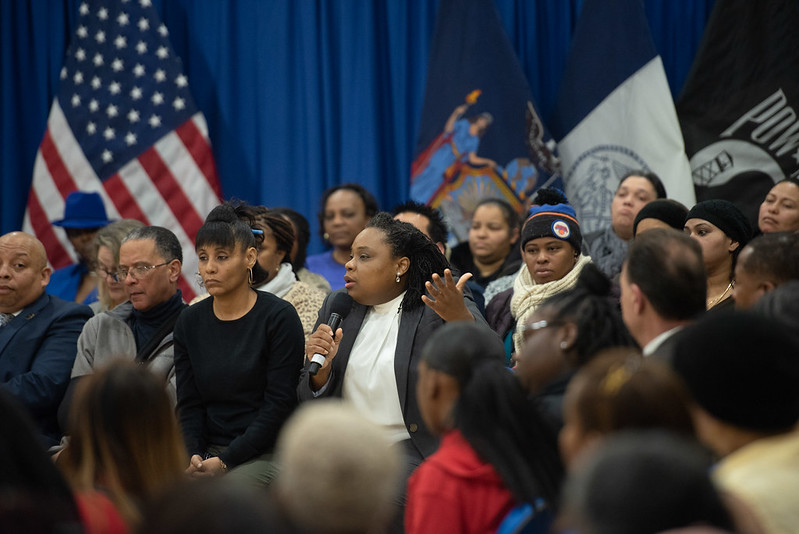
The 2021 elections have begun (photo: Michael Appleton/Mayoral Photography Office)
Running for office is an exciting endeavor and the already-underway 2021 New York City election cycle will be filled with new candidates, but the thing no one talks about is the difficulty of deciding to run for office or being a first-time candidate when it comes to quitting your job. Very few people can afford to leave their jobs behind without having to worry about paying for basic living expenses, such as rent, food, transportation, and health insurance. This barrier disproportionately prevents a slew of New Yorkers who are representative of our city from holding elected office, like young people, women, people with disabilities, and candidates of color.
We need to elect leaders who understand the challenges of everyday New Yorkers through lived experience, especially at a time when so many folks are struggling. It is time to support a new generation of leaders to effectuate policy changes at City Hall.
Current New York City leadership should move to further level the playing field and attract under-represented candidates reflecting our diverse communities. And one key way this should be done is by expanding the New York City Campaign Finance Board’s qualified campaign expenditures definition to include vital personal living costs.
Under my proposal, candidates who don’t hold elected office would be permitted to dedicate up to $20,000 of privately-raised funds toward reasonable living expenses. These funds could be used for rent, utilities, food, health insurance, public transportation, and other reasonable basic life expenses as approved by the Campaign Finance Board, as long as the candidate proves the need for each expense. Any amount spent above $20,000 would be used against the spending limit in the candidate’s race, limits that vary based on the elected office sought.
Precedent already exists to alleviate a candidates’ living expenses. Namely, the City Council passed Local Law 196 of 2018, sponsored by Council Member Keith Powers, allowing candidates to make campaign expenditures covering child-care services for children under 13 years of age, as long as public funds are not used. This landmark legislation helped pave the way for more primary caregivers, especially women, to run for office. Under this law, candidates could spend up to $20,000 on child care, though any expenditures in excess of this amount are subject to applicable spending limits.
Beside the obvious benefits, expanding permissible campaign spending to cover basic living expenses is sound public policy. It would not cost the city tax dollars, since the enumerated expenditures would be covered by privately raised cash, not the city’s public matching funds program.
Additionally, safeguards would adequately prevent abuse of the law by ensuring that candidates who fail to prove their need to use campaign funds for living expenses do not qualify to do so. As with child-care services, candidates would qualify for other living expenditures only if they provide a statement to the CFB and substantiation documents, requiring CFB approval. To prove that you lack the means to cover living expenses, candidates would have to produce documents detailing their assets, if any, as well as any relevant legal documents, such as a lease or a student debt note, among other things.
And, candidates would of course have to be able to raise the money that would be used to cover the basic living expenses, ensuring such funds are coming from private sources who support the candidate’s run for office.
In a city as expensive as New York, advanced financial planning and saving in preparation for a run for elected office may be a fanciful idea for far too many potential candidates. Many people are simply unable to save in significant sums given their wages and expenses. We must make it possible for single parents and working-class people to run for elected office. We need more young adults to run for office. You should not have to be able to save - or borrow - $10,000 or more in order to run for the City Council. And candidates should not have to work full-time while running for office in the lead-up to their election day.
As for me, I was fortunate to be able to save enough to cover the five months of rent leading up to the June primary I'm running in, for City Council in Upper Manhattan, but when I leave my job as a tenants’ rights attorney early next year, it remains unclear how I will pay for health insurance, food, or utilities for all of 2021. It shouldn’t be this way.
It’s time to further transform our campaign finance regulations to reduce inequalities that burden under-resourced candidates. Now is the time, just as the 2021 city election cycle is approaching and while the city faces a dire economic picture on top of existing crises, like unaffordable housing and generational poverty.
We must take additional steps to ensure that all potential candidates have an equitable opportunity at running for office, culminating in a diverse legislative body of people who understand what it is like to live under financial constraints and are reflective of the communities they’re elected to represent.
***
Shaun Abreu is a tenants’ rights attorney and a candidate for City Council in Manhattan’s District 7. On Twitter @ShaunAbreu.
***
Have an op-ed idea or submission for Gotham Gazette? Email This email address is being protected from spambots. You need JavaScript enabled to view it.
Supporting Law Enforcement and Reforming the NYPD are Not Mutually Exclusive — I Know From Experience
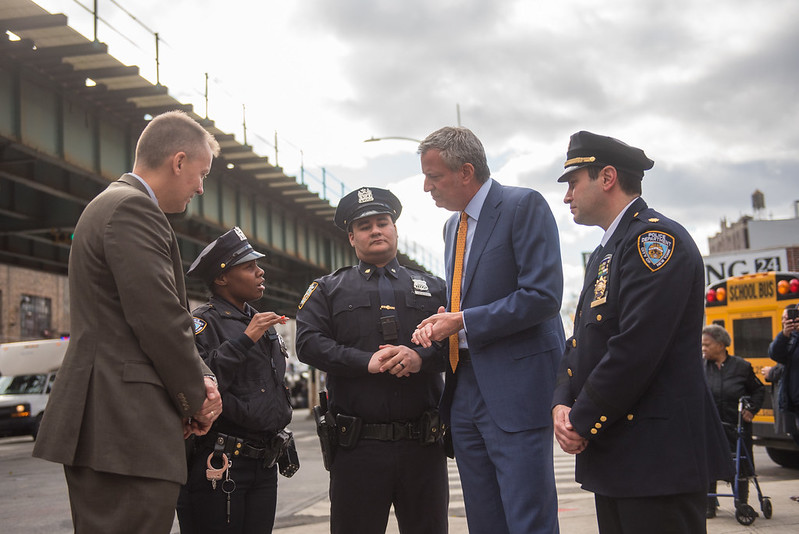
Mayor de Blasio and the NYPD in focus (photo: Michael Appleton/Mayor's Office)
When I joined the NYPD in 2013, I was an unlikely candidate for law enforcement. Nearly a decade earlier, during the 2004 Republican National Convention, I was a passerby arrested at a protest in Union Square. At the invitation of the New York Civil Liberties Union, I joined a class action lawsuit against the City related to those widespread arrests. Then, for several years after graduating from Harvard Law, I worked at a law firm and volunteered as a board member at the Bronx Defenders, a zealous criminal defense organization.
Many colleagues and friends were surprised when I joined the NYPD as a lawyer in the Intelligence Bureau, which had some vocal critics, including litigants who alleged the City had unfairly targeted Muslim communities in its counter-terrorism efforts. However, I saw it as an amazing opportunity to support the NYPD’s public safety mission, while also scraping away at any unfair or overly-broad practices.
Indeed, I spent much of my time at the Department over the past several years meeting with lawyers and advocates to discuss their concerns, share information about department practices, and work towards policy solutions that balance public safety and civil liberties, especially in the context of protests and other political activity. In these negotiations, the parties around the table often disagreed, but the dialogue was, almost invariably, respectful and productive, and we all left better informed and more appreciative of one another’s perspectives.
When I moved to my most recent role as counsel in the Police Commissioner’s Office, which I left a week before George Floyd’s death, I continued working on issues that require balancing civil rights and public safety, such as facial recognition and the local DNA database. Significantly, I was not a lone soldier in this work, but rather found it widely supported throughout the organization, especially at its highest levels. NYPD leaders often asked important, thoughtful questions: Is this policy fair, and is it the right thing to do? And when devising policy in response to social problems like drug abuse or mental illness: How do we really help people?
Following the senseless death of Mr. Floyd in Minnesota, the positive standing the NYPD enjoyed among most New Yorkers was overtaken by a tsunami of anti-police sentiment driven by a handful of recent brutal incidents. That these incidents occurred hundreds of miles from New York City did not blunt the rage unleashed against police officers in New York. The unrest was amplified by the social dislocation, anxiety, and hardship wrought by the pandemic. People were open to rage, had plenty of time to do it, and the NYPD presented a highly visible, omnipresent target.
The rage and vitriol directed towards officers was astounding and without modern precedent in New York. Yet through this windstorm, the NYPD sought to protect the rights of peaceful protesters and worked hard to distinguish among the various currents of activity pulsing through the city: the thousands marching in support of the Black Lives Matter movement, the violent agitators bent on destabilizing city life through arson and vandalism, and the scores of opportunists brazenly looting and burglarizing city businesses.
Even so, scorn from the public and many media outlets mounted and whipped, creating an echo chamber in which seemingly all police officers—even those at the NYPD, a majority-minority department for over a decade—were viewed as suspected racists or oppressors. Worse still, many public officials in New York City pandered to the protesting crowds, even though they have access to facts that inform a more nuanced view.
Certain voices were greatly amplified and some rightly so. However, others were excluded from the conversation about policing, including many people who live and work in New York and put a premium on public safety. They do not want to “throw the baby out with the bath water” when it comes to the NYPD and the maintenance of public safety. Some privately emailed me, expressing dismay. No doubt people of this mindset express their views in muted tones, if at all, for fear of being targeted and labeled by the pernicious, intolerant political culture that marks our day.
But make no mistake: despite current false narratives that police are broadly racist, trigger-happy, or both, it is not morally inconsistent to respect police (and the rule of law) and to oppose brutality and prejudice in all its forms. Yet many people feel backed into choosing between two positions: pro-law enforcement or anti-racism.
This stark choice is forced on us by political opportunists and by individuals who are prone to selectively defending free speech while seeking to ostracize people with opposing views. They rarely mention crime victims or the NYPD’s role in suppressing violent crime. In our increasingly brittle political environment, it’s unsurprising that few, even among our elected leaders, seek to articulate a more nuanced, fact-based view.
That is not to minimize the reality that some officers exhibit prejudiced behavior or even engage in criminal violence. But these officers are the few, not the many, and clear-cut remedies exist: better training, and where necessary, discipline or criminal prosecution. What we know is that blaming a whole group of people, who share a race, religion, or in this case a vocation, for the bad acts of a few leads to unjust results and divisiveness. But this is what has happened.
Scathing, dehumanizing depictions of our City’s officers by certain activists, politicians, and media outlets bear no resemblance to the Department I came to know through years of service. Rather its members are predominantly committed, hardworking public servants. They come from many different racial, ethnic, and religious backgrounds. Most come from working-class backgrounds. Many are immigrants or the children of immigrants. While many among them are idealistic, their job is complicated by harsh realities with historical underpinnings, including significant racially-disparate patterns in crime victims and perpetrators.
The NYPD that I know responds to criticism, continually strives for improvement, and is fundamentally guided by a commitment to the public good that we can all respect. Forced to decide between the NYPD and standing against brutality and racism, I choose both.
***
Ashley Waters served as NYPD Counsel for Intelligence Affairs from 2013 to 2018 before becoming Counsel to the NYPD Police Commissioner from 2018-2020. She is now an adjunct professor of law at University of Virginia School of Law.
***
Have an op-ed idea or submission for Gotham Gazette? Email This email address is being protected from spambots. You need JavaScript enabled to view it.
We are Justice-Involved Women of Color; And We are 2020 College Graduates and Innovators
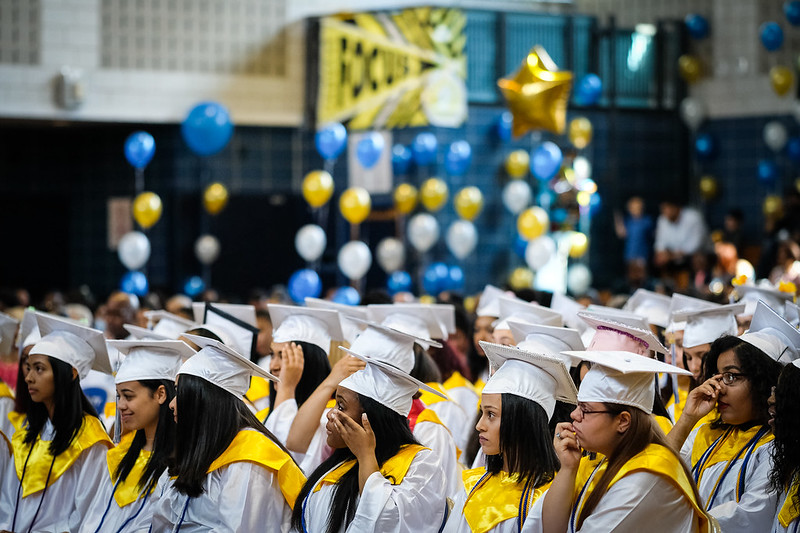
Graduates (photo: Edwin J. Torres/Mayor's Office)
Plagued by a pandemic and confronted by a national outcry against racial injustice, our final semester in college was challenging at best. As nontraditional students and Black women directly impacted by a deeply-flawed criminal legal system, we are no strangers to adversity. We consistently prove, time and again, that we can succeed despite our backgrounds.
That success is predicated on an unmovable foundation that reframes our relationship with the world and the issues we face today – a college degree. A college degree is transformative. A college degree is a means to a better life that reverberates hope and opportunity across generations and throughout communities.
Even in the current economic climate, our degrees provide a critical buffer against unemployment and financial volatility. Not only does this stabilizing effect demonstrate the importance of higher education to our families but it also increases the chances relatives and others we know will seek out a college degree, breaking the cycle of multi-generational poverty.
However, while the motivation to earn our degrees was always present, the systemic barriers limiting our ability to successfully achieve that outcome were pervasive. How would we pay for college? What colleges and universities will even accept us?
These questions, while not uncommon for most Americans, become even more damning when you have a criminal conviction. Just ask the millions of Americans currently struggling to surmount the lifetime of collateral consequences that come with their conviction status. Most will never find the crucial social supports required to access opportunities that extend beyond their present circumstances.
Our pathway to and through college would not have been possible without community-based organizations that delivered the necessary resources and tools to help guarantee our success. These spaces offered structure and community that empower women of color to recognize our worth and, ultimately, to achieve our goals.
They provided one-on-one academic counseling that guided us through institutional bureaucracies, community meetings that gave us safe spaces to ask difficult questions, and advocacy training that taught us how to build a movement. All of the programming was tailor-made for justice-involved women like us.
We became part of a sisterhood of women supporting women and our voices, which often go unheard, were not only heard but valued. This enabled us to break out of the box society had put us in and define ourselves for who we truly are – women who can create change.
That change includes empowering other marginalized people to embrace their intimate understanding of oppression, mass criminalization, and intergenerational poverty. In doing so, they too can recognize that they are best positioned to find the most effective solutions to the problems facing their families and communities.
Coupled with our lived experience and the full power of our degrees, we are committed to creating similar spaces that teach other justice-involved people that their criminal conviction status is not a terminal diagnosis. A space where people with criminal histories can achieve the same confidence and credentials to realize their full potential and pay it forward.
Robert Merton, considered to be the founding father of modern sociology and a contributor to the subfield of criminology, created the Strain Theory — a theory that puts society in five classes: conformity, ritualism, retreat, rebellion, and deviance. A deviant was once considered a criminal, people whose behavior fell out of society's norms. Now, when you look up Merton’s theory, deviant is replaced with innovator: people who have created promise, opportunities outside of society's norms.
As we’ve replaced our caps and gowns with masks and cardboard signs, we’ve begun our new, fully realized futures, invoking our role as innovators. With our degrees in hand, we’ve set out on a mission to build a better path for those that come after us by disrupting and dismantling a system where only few can succeed. We do not forget our past, but now, because of our education, we demand access to a promised future that provides opportunity for all.
***
Chermaine Black graduated this year from Columbia University with her Master of Social Work and is an alumna and 2020 Valedictorian of College & Community Fellowship – an organization working to help justice-involved women earn their college degrees. Shannon McCarroll graduated this year from Lehman College with her Bachelor of Arts in Sociology and is an alumna and 2020 Salutatorian of College & Community Fellowship.
***
Have an op-ed idea or submission for Gotham Gazette? Email This email address is being protected from spambots. You need JavaScript enabled to view it.
Removing NYPD from Homeless Outreach is a Long-Overdue Positive Step; Here’s What Must Come Next
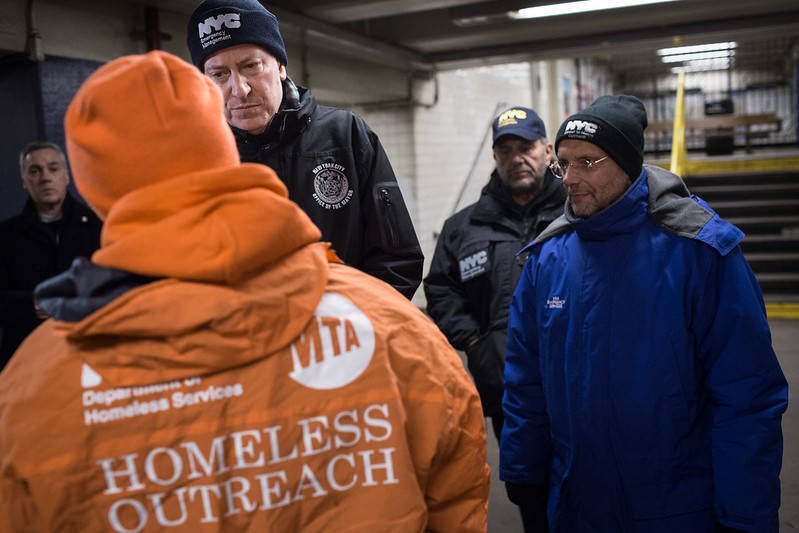
Mayor de Blasio with homeless outreach (photo: Michael Appleton/Mayor's Office)
As the city gradually reopens, we’ve seen many homeless New Yorkers kicked off the subways without being offered a safe, private alternative place to sleep. In some recent cases, we have seen police officers use unacceptable violence to drag homeless New Yorkers off the train. Fortunately, after repeated calls from homeless New Yorkers and advocates, New York City finally announced homeless outreach will be shifted away from the NYPD and be done entirely by the City’s social services agency.
Though we are grateful the city made a right decision after months of failed policies, significant damage has been done since the overnight subway shutdowns began in May. Removing police from homeless outreach must be only the first step -- now, we need to gain the trust of our homeless neighbors and actually offer them the safe shelter options and permanent housing they need and deserve.
For months, we have raised concerns about the subway shutdowns, only for Mayor de Blasio to brush off our criticism and spin his own message. After the first three weeks of the nightly subway shutdowns, the mayor boasted that 1,700 people were engaged, 506 unique individuals accepted shelter placement, and 281 of them remained in shelters. He declared success, and has continued to point to the nightly shutdowns as a welcome opportunity to engage homeless New Yorkers.
According to the Department of Homeless Services, between May 5 and July 19, 2,823 individuals accepted referrals to shelters from the subways, 955 individuals accepted placements after they were transported from the subway, and 437 of these individuals remain in shelter placements. Yet, the mayor has failed to acknowledge the reasons why people bed down in the subways in the first place, and has ignored the distrust and anxiety homeless New Yorkers experience due to being kicked off the trains every night.
For example, hours before the first nightly subway shutdown was scheduled to begin, we received a desperate email from a homeless New Yorker who had been sleeping in the subway system for two years: “Please, if you can find a way to get me into one of these hotel rooms, I’d be very grateful. Tonight, I may visit the ER, and fake some chest pains, just to have a place to relax for a bit. But, I can't do that every night. I legitimately have PTSD from the shelter system, from my last time on Wards Island. It is not an option for me. I am begging you, if you can, please help me.”
Despite the existence of tens of thousands of vacant hotel rooms, Mayor de Blasio has largely resisted calls to offer direct hotel placements for people being kicked off the subways. He has argued that they could not get services in hotels – contrary to the belief of several outreach workers – and instead offers them transportation to the same crowded, congregate shelters many of them have made a conscious decision to avoid due to the risk of exposure to COVID-19, among other reasons. In recent weeks, the city has opened some low-threshold shelter beds in hotels, but they have not been consistently offered to everyone being removed from the subways.
Even so, Mayor de Blasio has gone on about the number of homeless New Yorkers brought to shelters or hospitals without mentioning the overcrowded chaos often found in shelters.
When these individual human stories of the subway shutdown are reduced to numbers, the reality can be easily distorted, even portrayed as a success. Through the past few months, Coalition for the Homeless monitors have witnessed homeless New Yorkers being kicked off the subway without being given adequate alternatives. Police, rather than outreach workers, are usually the ones who wake people and tell them to leave the train. In fact, at many stations, there are only police officers present, no outreach workers.
Mayor de Blasio’s rosy proclamations ignore the fact that shuffling people between crowded congregate shelters and hospitals during a deadly pandemic is no victory. The role of police in the nightly subway shutdown has been one more example of the mayor’s reliance on the NYPD to move homeless New Yorkers along, rather than addressing the root causes of homelessness -- and his defense of aggressive police actions against homeless New Yorkers reveals his failure to grasp the negative ramifications of these misguided policies, which understandably make people more distrustful of outreach workers and others seeking to help them.
Now, with outreach finally shifted away from the NYPD and into the hands of social services, we hope to see an end to the criminalization of homelessness. But we must go further and give outreach workers the critical tools needed to help homeless New Yorkers obtain permanent housing, a vital resource that, now more than ever, fundamentally serves as health care. New York City must provide housing assistance to help people relocate out of the transit system, off the streets, and out of crowded shelters, and into homes of their own.
For years, we have called on Governor Cuomo and Mayor de Blasio to invest in housing as a solution to homelessness. We have long argued that to reduce the tragedy of people sleeping on the streets and in the subways, they must be offered somewhere better to go. New Yorkers should not have to endure nightly removal from the subways without being provided with a safe, private place to protect themselves.
Moving away from police reliance is a massive step. We owe it to our homeless neighbors to keep fighting for something better, during and after the pandemic.
***
Jacquelyn Simone is Policy Analyst at Coalition for the Homeless. On Twitter @NYHomeless.
***
Have an op-ed idea or submission for Gotham Gazette? Email This email address is being protected from spambots. You need JavaScript enabled to view it.
What Prosecutors Must Do To Fight Anti-Semitism
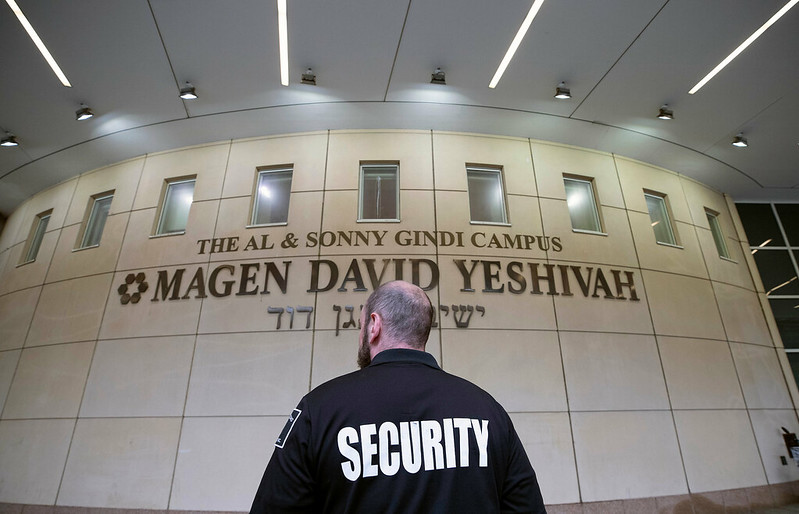
Security at a yeshivah (photo: Mike Groll/Office of Governor Andrew M. Cuomo)
A newly-released report by the Anti-Defamation League paints a stark and troubling picture: anti-Semitism is on the rise, with incidents of assault seeing the largest increase. Rising coronavirus-related hate crimes, coupled with the not-too-distant memory of the death of Rabbi Josef Neumann, a victim of the Hanukkah attack in Monsey, New York, are powerful reminders of the urgency needed to identify and implement improved solutions for acts of hatred.
Beyond violent attacks like those in Jersey City, Pittsburgh, Poway, and Monsey, incidents of anti-Semitic crime in New York City and across the country have spiked to their highest levels in recent memory. But the troubling rise of anti-Semitic hate crimes goes beyond New York, extending across the county and the world.
Prosecutors, the elected standard bearers for fairness and justice in our communities, can rise to the occasion and treat this issue with the urgency and gravity that it demands, but they must also be supported through the creation of tools for increased reporting of such crimes, and legislative change to facilitate prosecution. The Anti-Semitism Accountability Project’s recently-launched portal for victims of hate crimes and New York State’s Hate Crimes Domestic Terrorism Act are positive examples of creative solutions to support the prosecution of this ancient and pervasive scourge.
Perhaps it comes as no surprise that, with memories of World War II fading and Holocaust survivors dwindling in number, anti-Semitic people have felt emboldened to reignite centuries of hate. The relative silence in the face of these acts should be of concern to us all. I have written about the need to identify hate crimes and domestic terror for what they are in order to prosecute white supremacist violence, and the same principles should apply to anti-Semitic conduct.
As anti-Semitic conduct tends to be under-reported and underestimated, inadequate law enforcement resources are directed towards addressing the problem. Encouraging victims of anti-Semitism to come forward requires open communication between communities and prosecutors, and assurances that hatred will not be tolerated. Increased reporting will better improve understanding and tracking of and response to the alarming rise in anti-Semitic crime.
With improved reporting, prosecutors can also address the increase in these crimes by proactively working with communities to provide education on the issues; indeed where anti-Semitism is driven by ignorance or lack of social proximity and connection, prosecutors may direct resources to build bridges between faith-based and other communities. By working to address the underlying cause of the increases in anti-Semitic crime, prosecutors can help keep communities safe by preventing further crime.
Once crimes are properly reported, Governor Andrew Cuomo’s recent legislation, which characterizes some hate crimes as domestic terror, is a model for how to provide enhanced tools to law enforcement to investigate and prosecute these crimes. It also serves as another step towards achieving the cultural shift that real lasting change requires, expressing the core American values of tolerance and inclusivity. And now as much as ever, with a rising tide of anti-Semitism, prosecutors can be advocates for the right of the Jewish people -- and indeed, all people -- to live peacefully and free from insidious hate.
As with all hate crimes, prosecutors’ responses to anti-Semitism must be tailored to ensure an effective criminal justice system response that values the long-term safety of all community members, and this may include and go beyond traditional law enforcement tools.
As in all crimes, people charged may suffer from mental health challenges, and the appropriate redress may include treatment, pro-social programming, community service, or even restorative justice -- the ancient practice in which a person who has caused harm meets with a trained professional and the survivor of a crime to learn about the harm they have caused and begin to take responsibility and try to facilitate the survivor's healing.
The integration of educational and restorative principles may prove particularly useful when a perpetrator lacks understanding of the damage anti-Semitism has wrought over the centuries and the harm it continues to inflict. This approach has been met with some success abroad for handling anti-Semitic crimes. Much as they should do with any impacted group, prosecutors should collaborate with community leaders and crime victims, and should tailor the criminal justice response to consider the harm caused, as well as the overall safety of all.
Throughout history Jewish people have often been forced to live in fear, whether from the apparatuses of government or from social ostracism. At this daunting moment in our history, with accurate information and adequate legal tools, our local prosecutors -- the elected ministers of justice in our communities -- can be bastions of good in the face of hate.
***
Lucy Lang is the Director of the Institute for Innovation in Prosecution at John Jay College, and a former Assistant District Attorney for Manhattan. On Twitter @LucyLangNYC.
***
Have an op-ed idea or submission for Gotham Gazette? Email This email address is being protected from spambots. You need JavaScript enabled to view it.
Two Keys to Solving the City’s School Crisis
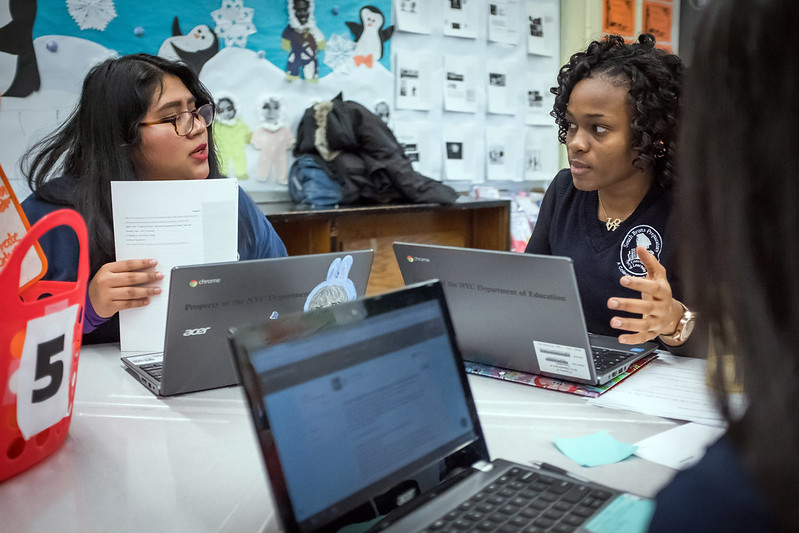
Students at work (photo: Ed Reed/Mayoral Photography Office)
The way our children are being educated has changed dramatically by this COVID-19 pandemic. As a working mom, it feels like I’ve been running a marathon and someone keeps moving the finish line. Mayor Bill de Blasio and schools Chancellor Richard Carranza have thus far been unable to give working families a clear plan for how our children can safely return to school in the fall.
The options offered by the de Blasio administration are to either continue with full-time remote learning or a hybrid model with two or three days of learning in the classroom and the others at home. Both options pose major challenges for working parents who can't afford child care, though the mayor also says the city is working on a supplemental child care plan.
All of this lacks essential details just weeks before the start of the school year.
One thing is clear, though: the pandemic has illuminated decades of inaction. New York City’s neglect to adequately fund education and address overcrowded schools is now exacerbating a public health crisis. COVID-19 may not go away for the next several years and we need to start coming up with better and sustainable solutions that will ensure our kids can continue to receive a high-quality education. It's about time we address key issues once and for all.
Short-term, deal with the remote learning model.
If parents are now required to fill the role of teachers when they pay hard-earned tax dollars for education in this city, then at the very least, they should be given a child-care subsidy in the short-term while the city works on more long-term solutions of smaller class sizes. It’s only equitable to reallocate tax dollars to working families, as they will either have to pay for a caregiver or tutor, or take time off of work to ensure their children stay on track.
Each family with children in pre-kindergarten through fifth grade should receive a voucher per child for the year that would cover the costs of child-care, and parents with older children would receive a voucher to hire in-person tutors.
Long-term, the city must finally deal with overcrowded schools.
Overcrowding is not a new problem, but the neglect of politicians has now become an added layer to the public health crisis that stands in the way of our children receiving quality education, and will further perpetuate the growing inequality in the education system.
According to estimates from Class Size Matters, we need about 100,000 more seats to fix overcrowding, and Queens is the borough with the most overcrowded schools. In order to truly eradicate poverty and build a more equitable city, we have to do everything we can to ensure high quality education for the 1.1 million kids in our school system.
We need to start by hiring more teachers.
Class Size Matters proposed allocating $200 million of the $26.9 billion New York City Department of Education budget toward class size reduction by hiring 1,000 new teachers, starting in kindergarten through third grades. Not only is this the right thing to do, we should also explore using parochial schools or other spaces that could be leveraged into public school classrooms if needed, and advocate for the construction of new school campuses.
According to Class Size Matters, class sizes in New York City schools are 15-30% larger than in other parts of the state, and the number of children in first through third grades in classes of 30 or more students has risen by nearly 3,000% since 2007.
Former City Council Speaker Peter Vallone established an initiative that forced the city to cap all classes at 28 students but the DOE no longer follows those guidelines. Those guidelines must be revisited and enforced through legislation. Class size reduction means quality education for our children, and according to a United Federation of Teachers survey, 99% of New York City teachers believe class size reduction would be an effective reform to improve city schools as over 336,000 students are currently in classes of 30 or more.
As a mother of two I can say one thing is certain: this situation serves as a reminder of just how vitally important it is that parents, particularly mothers, have a place at the table to fight for our kids. New York City families cannot have a repeat of what happened in the spring, or this city will continue to see families exit. It will be interesting to see if the demographics of young families will change, but my hope is that we can create a solution that will help us retain families that build into our city.
The last thing we need is a generation of students falling behind, and the systemic inequalities that will grow as a result.
***
Felicia Kalan is a candidate for the New York City Council in District 22 in Queens. On Twitter @KalanforQNS.
***
Have an op-ed idea or submission for Gotham Gazette? Email This email address is being protected from spambots. You need JavaScript enabled to view it.
Diploma Privilege Now
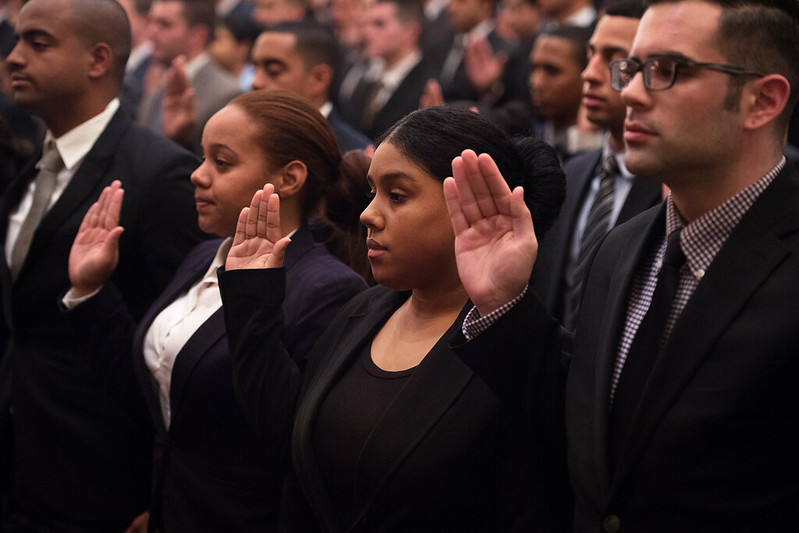
Taking the oath (photo: Demetrius Freeman/Mayoral Photography Office)
James, whose name we’ve changed for confidentiality, is a recent law school graduate living in Brooklyn. Their partner had been the household’s sole income-earner — covering rent, food, and more — until she lost all employment during the COVID-19 pandemic and has not been able to get a new job. The couple now survives through unemployment checks, which could be reduced by 60% or more at the end of this month. James had to fund their law school education almost entirely through student loans, with payments due starting at the end of 2020. And they are still waiting to take the bar exam — the sole barrier between law school graduates and becoming licensed lawyers with all the responsibilities and job opportunities that come with such status.
Thousands of other law school graduates are also waiting, because no graduate knows when a safe, equitable New York bar exam will next occur. The COVID-19 pandemic changed everything for everyone, law grads included. This week, 23 states will force thousands of law school graduates to risk their lives to take a test. New York has been a different kind of nightmare. In March, the New York Court of Appeals postponed the July bar exam to September. On July 16, the Court of Appeals informed these students that the bar exam needed to be delayed once again due to concerns over both in-person and online exams, only to announce just days later, it will hold an online exam in October.
The uncertainty surrounding the New York bar exam has been devastating. After the March news, thousands of job offers were delayed or revoked until the September exam date, leaving students without salaries and health insurance, and with far more uncertainty and insecurity. Unemployed graduates were left to job hunt during an unprecedented pandemic. The lack of clarity for recent graduates has left many in limbo, wondering how or when they can pay for rent, food, health expenses, or their pending debt from law school. It also further exacerbates mental health inequities in a field long known for widespread depression and mental health stigma.
The only compassionate and equitable option for New York’s future lawyers right now is diploma privilege.
Under diploma privilege, applicants can be admitted to the bar without taking a bar exam but following successfully graduating from law school and satisfying certain other requirements like passing the New York Law Exam and the Multistate Professional Responsibility Exam and completing a “character and fitness” assessment.
Many have suggested alternatives to the in-person bar exam: Why not prepare an online bar exam? Why can’t law graduates just receive provisional licensure until the next bar exam in February 2021?
While we respect the New York Bar’s awareness of the risks an in-person exam currently poses, the announced or proposed alternatives are neither sufficient nor equitable. Online exams disadvantage test-takers lacking stable internet access — what if applicants are kicked out mid-exam due to unreliable internet? — and risk test-takers’ data privacy. Lawyers and disabled rights advocates are also concerned online exams will likely not grant the flexibility needed to make the exam truly accessible. Screen-related health and accessibility issues and the application window already being closed for accommodations means that currently-granted accommodations may not work for the October exam. Provisional licensure — temporary licensure until the bar exam is offered — furthers uncertainty for applicants and employers alike. It requires employers, such as already over-stretched legal services providers, to reduce supervising attorneys’ caseloads to supervise provisional licensees. Plus, the bar exam takes a long time to prepare for. By requiring applicants to take the bar exam in some unspecified future, provisional licensure disproportionately and negatively harms applicants who cannot obtain legal employment or take time off from work for full-time study.
The exam is also an equity issue. For instance, in-person exams risk harming applicants who live in multi-generational homes or live with immunocompromised family members. United for Diploma Privilege - NY (UDPNY) surveys have shown these applicants are more likely to be women and/or Black, Indigenous, and people of color (BIPOC). But if New York adopts the National Committee of Bar Examiners (NCBE) guidelines, the online exam would still disproportionately harm disabled applicants by requiring applicants requiring accommodations to complete their exams in person. New York legal leadership claims to care about diversity, inclusion, and lawyer mental health and well-being. Yet all of these options disproportionately harm BIPOC, low income, disabled, first-generation, and chronically ill bar applicants — the people the bar exam was already most inaccessible to.
Diploma privilege is neither a radical nor a new idea. Wisconsin has long offered diploma privilege, with noted beneficiaries including the NCBE’s president, Judith A. Gundersen. Washington, Oregon, Utah, and Louisiana have granted diploma privilege to students from ABA-accredited law schools in response to COVID-19. And measures to pass diploma privilege in New York have popular support from graduates, local legal employers and unions, and now, every law school dean in New York.
There are two paths to diploma privilege in New York. The Court of Appeals could still offer diploma privilege to all graduates from ABA-accredited law schools rather than insisting upon an unproven online exam. If it makes the equitable decision to extend diploma privilege, the Court could subsequently provide important regulations to ensure these graduates would receive additional training through its preexisting Continued Legal Education programs.
Alternatively, State Senator Brad Hoylman and Assemblymember Jo Anne Simon are sponsoring a bill to license J.D. graduates from ABA-accredited schools who otherwise satisfy the requirements of the New York Bar. This bill would provide immediate, necessary relief to thousands of recent graduates.
Diploma privilege is an equitable and sound solution that would provide advantages to recent law school graduates and New York State overall. Graduates would receive needed licensure while New York can simultaneously strengthen its legal system with the inclusion of competent, energized young lawyers. An online exam does not ensure equity. We can’t pretend things are still business as usual in any field, law included. More than ever, New York needs diploma privilege now.
***
Winn Periyasamy, MPH, is a policy advocate, writer, and second year law student at Fordham Law School. Mary Kate Cunningham is a recent graduate from Fordham Law School and a member of United for Diploma Privilege - New York. On Twitter: @wperiyasamy & @MKCunningham91. Thanks to Matthew Cortland, Kathy Flaherty and Alex Petkanas for their feedback in writing this piece.
***
Have an op-ed idea or submission for Gotham Gazette? Email This email address is being protected from spambots. You need JavaScript enabled to view it.
What Those Targeting the SHSAT Don’t Really Understand About the Specialized High School Picture
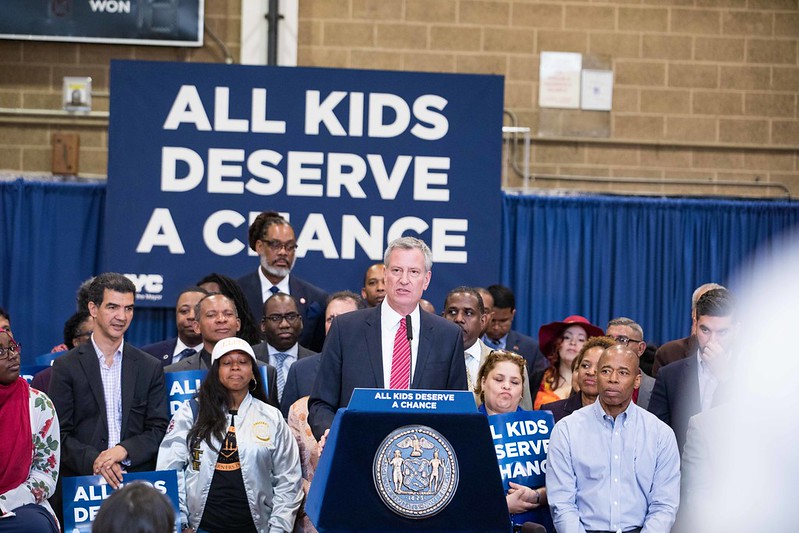
Mayor de Blasio announces specialized high school plans (photo: Benjamin Kanter/Mayor's Office)
One of the most controversial topics in the New York City public education system is the Specialized High School Admissions Test (SHSAT) and its use as the sole tool for admission to the city’s eight premier STEM-oriented specialized high schools. There has always been a robust debate about the admissions process, because while the New York City public schools are predominantly African-American and Latino (about 68% of students), these populations represent only 10.4% of the students admitted to the specialized high schools.
As an African-American student and recent graduate of one of these specialized high schools, Brooklyn Technical High School, it pains me to see my peers and others writing op-eds using severely misguided arguments in opposition to the test.
While we must solve the lack of racial diversity in the specialized high school system, abolishing the test is not the right way to do it, for several reasons.
As an African-American student at and now graduate of Brooklyn Technical High School, I of course am disheartened by the low admission rate of Black and Latino students. It is something I noticed as soon as I entered freshman year, especially coming from Medgar Evers College Preparatory School in Crown Heights, my middle school where almost everyone looked like me. So during my four years in high school, I decided to take action to help remedy the issue.
I participated as part of the Department of Education’s Specialized High School Outreach team, where hundreds of students come to gain information about the city’s eight specialized high schools and the SHSAT. I offered a student perspective of the specialized high school experience, advised students about preparing for the SHSAT, and counseled them about what to expect on test day.
Perhaps most significantly, my father and I founded a tutoring program designed to prepare underserved middle school students for the SHSAT in my home neighborhood of Southeast Queens. It was during this program where I saw so clearly that students simply weren’t receiving adequate tools to succeed from the New York City public school system. Throughout the course of this tutoring program, I have had the opportunity to interact with dozens of students. Ultimately, I have been impressed with their enthusiasm and engagement, yet frustrated by the students’ inadequate preparation — many did not have simple multiplication and division skills.
It upsets me that all of these students have ample potential, but they don’t stand a chance during the specialized high school admissions test due to the lack of strength in curriculum and pedagogy at their elementary and middle schools. It became quite apparent to me that the mayor and other anti-SHSAT officials have used the test as a scapegoat for the lack of diversity in the specialized high school system, rather than aiming to reform the weak learning environments, standards, and curriculum in the city’s public elementary and middle schools.
Moreover, it appears that many of these officials have simply dismissed the drastic consequences of abolishing the test. The SHSAT itself offers the opportunity for a standard, relatively unbiased opportunity across the city, with each student interested in specialized high school admission taking the same exact test in a given year. If the SHSAT is abolished, the main tool of admission will be students’ middle school grade point averages (GPAs).
We know every student can’t take nearly the same exact classes and have all teachers across the city teach similar curriculum and grade the same exact way. In reality, it is pretty easy to get an ‘A’ in an arithmetic class passed off as something more challenging, and equally easy to get a ‘C’ or a ‘D’ in a very challenging class where there may even be significant grade deflation. Sending a student with straight A’s in fairly easy classes that inflate grades to a specialized high school would be extremely unfair and discouraging to students who have challenged themselves with difficult classes and didn’t get the grades they desired.
It would also be doing these particular straight-A students a disservice to send them to specialized high schools, where the workload is much more difficult and requires prior mastery of fairly difficult topics (topics that are covered on the SHSAT). The SHSAT allows schools to test students’ abilities in subjects, particularly math and English language arts, that are imperative to have a strong foundation in before entering a specialized high school. The pace is fast at the specialized high schools, meaning the importance of a solid foundation in subjects across the board is essential.
There’s also a misleading narrative out there about the racial demographics of the specialized high school system. As I mentioned, it was quite easy to notice how many people didn’t look like me during my time at Brooklyn Technical High School.
But, I have never in my academic career felt that my school was any less of a melting pot than the city it resides in. Part of why there is such a popular misconception about the demographics of the specialized high schools is because of the misleading statistic that the schools are 60% Asian. Although this statistic is broadly accurate, it becomes significantly less relevant to the larger discussion when you realize the different demographics that are included in that daunting number.
For example, I’ve met and been friends with many students from Bangladesh, Korea, India, Uzbekistan, the Philippines, and beyond, all of which are covered in the category of Asian and the 60% number so often thrown around. The reality here is indicative of the lack of nuance in the overall discussion around the specialized high schools, the test, and diversity.
In all, the lack of Black and Latino students in specialized high schools is a problem that absolutely needs to be addressed, but abolishing the SHSAT is the wrong way of going about it. The mayor and schools chancellor need to stop using the test as a scapegoat for their inadequacies in providing a strong education to elementary and middle school students throughout New York City.
***
Amir Davis is a 2020 Brooklyn Tech graduate who will be attending Stanford University in the fall.
***
Have an op-ed idea or submission for Gotham Gazette? Email This email address is being protected from spambots. You need JavaScript enabled to view it.
A Promising New Plan to Save New York City Public Housing
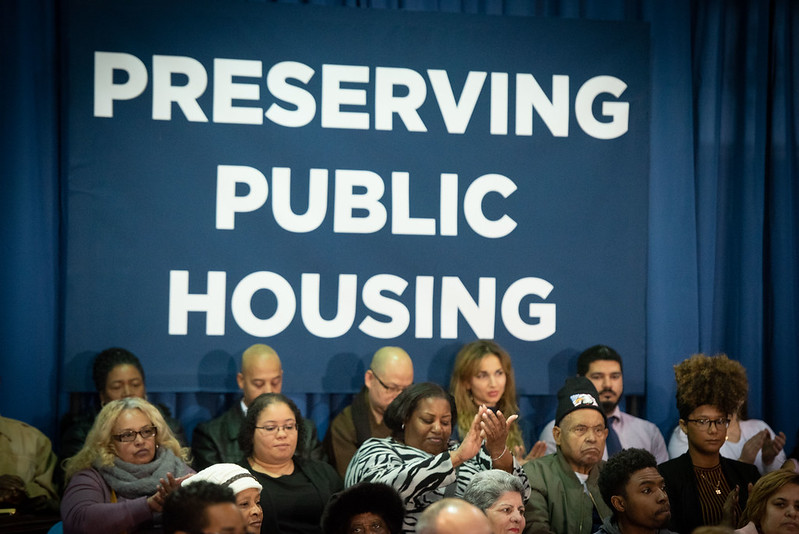
NYCHA needs to be saved (photo: Michael Appleton/Mayoral Photography Office)
The New York City Housing Authority is putting forward a promising new plan to preserve each public housing unit in its portfolio. Mayor Bill de Blasio, and previous mayors, have put forward multiple plans intended to save NYCHA, but this one bears attention and support because with sufficient community input and political support, it has a real chance of success.
For more than half-a-million renters in New York City — a city within the city — public housing has provided reliable affordability during these tumultuous times. About 1.2 million renter households in New York City have lost income due to the devastating COVID-19 pandemic and many face eviction without federal aid, but not in public housing. For public housing residents, rents are adjusted to offset lost income. This protection against income volatility is invaluable for low-income renters. And for many, it is the reason why they tolerate the frustrations of living in public housing, such as leaking pipes, heat outages, mold, and lead paint.
But New York City’s public housing, under the watch of a federal monitor, is at risk with a mounting backlog of capital repairs most recently estimated at $40 billion. To address this crisis, NYCHA is exploring an innovative new strategy to complete the preservation of its entire approximately 175,000-unit portfolio.
To date, NYCHA’s preservation plans have centered on leveraging public-private partnerships to raise revenue through PACT (NYCHA’s version of HUD’s Rental Assistance Demonstration program), as well as infill development and the sale of air rights. More than 60,000 units and $24 billion are slated to move forward under these programs but this falls far short of raising the $40 billion needed to fully address NYCHA’s rehabilitation needs. But until now, no credible plan had been put forward to preserve the remaining, approximately 110,000 units of public housing in need of repairs across the five boroughs.
NYCHA’s new strategy to create a Public Housing Preservation Trust is still at the early stages of crafting, but it provides the vision for creating a bold and comprehensive approach to financing and preservation, while keeping intact protections for residents. It cleverly uses HUD’s own disposition rules to identify a financing solution.
The plan centers on unlocking Tenant Protection Vouchers, which would be triggered through disposition, and allow higher funding levels. For the many residents and advocates who want to keep public housing in public control, they will be relieved that disposition will be made to a new publicly-controlled entity — the NYCHA Preservation Trust. This new entity will borrow against federal rent subsidies to finance repairs. It will also contract management back to NYCHA, retaining its unionized workforce, and it will have the ability to hire private sector contractors to help make repairs.
A solution for our era of climate change, it also banks on energy savings and anticipates the creation of a significant number of green jobs.
In this new strategy, there are many elements that will appeal to residents, advocates, and elected officials concerned about long-term affordability, tenant protections, and the urgency of needed repairs. And since the plan is not set in stone, there are many aspects that can be further developed to reflect their concerns and aspirations.
To succeed, however, this strategy needs broad public support. It will need endorsement from NYCHA residents, which the housing authority should seek for any major policy change. NYCHA must follow through with robust resident engagement.
The plan will also need state and federal action. The New York State Legislature, working with Governor Cuomo, will need to pass legislation to create a state-chartered public benefit corporation, similar to the School Construction Authority. The state should use this opportunity to improve oversight and also to ensure formal resident representation on the board of the new entity with decision-making power.
This new trust will be responsible for the preservation of a portion of New York City’s invaluable public housing stock, the improvement of its living conditions to meet federal standards, and its long-term affordability. The new structure will need to include reforms and improved accountability. Not all of NYCHA’s past mismanagement and compliance failures can be blamed on lack of funding and changes are necessary.
At the federal level there are two critical changes needed for this plan to work. The first is that HUD must change its policy on issuing Tenant Protection Vouchers to units only after they pass inspection for compliance with federal standards. To raise financing for needed repairs, the rental assistance must flow first. If the federal government is not going to fund repairs directly through the public housing capital fund, then they must allow NYCHA this flexibility.
Finally, Congress must significantly increase appropriations for Tenant Protection Vouchers to support this plan. This will be less costly than fully funding the public housing capital budget so it is not unrealistic to expect some bipartisan appeal to this approach.
While NYCHA has more work to do to refine this strategy and gain support over the next months, now is exactly the time when public investment in housing matters most. As a city, we must value and prioritize the preservation of our public housing. Like our public schools, public libraries, and our public parks, public housing is a critical component of our community infrastructure. NYCHA’s proposal, which complements its PACT initiative, offers a chance to preserve public housing while reimagining the public’s role in this vitally needed housing.
***
Rachel Fee is Executive Director of the New York Housing Conference. On Twitter @RachelFeeNYHC & @theNYHC.
***
Have an op-ed idea or submission for Gotham Gazette? Email This email address is being protected from spambots. You need JavaScript enabled to view it.
Neither Quality Nor Quantity: Mayor De Blasio’s Unworkable School Reopening Plan
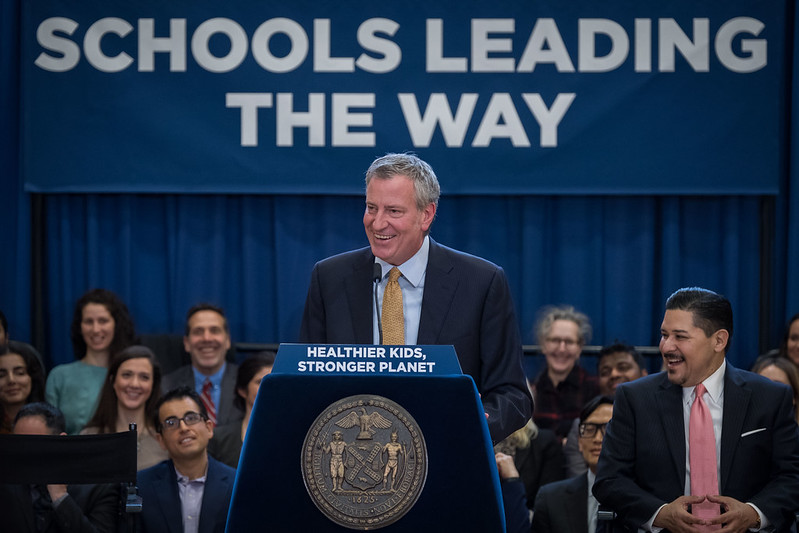
Mayor de Blasio & Chancellor Carranza (photo: Ed Reed/Mayor's Office)
Many of my colleagues are discussing whether or not it’s safe to go back to school buildings in New York City. Will buildings that were never clean before become clean now? Will buildings that were never properly ventilated suddenly become state of the art? Will children and teenagers observe social distancing in and out of school? I’ll leave all that to your imagination and focus mostly on the pedagogical.
It’s not hard to explain the best possible way to administer education. I know well, because I’ve been doing it for decades. Face-to-face instruction is optimal. I can give immediate oral and written feedback. My students can work with one another in pairs or other small groupings to reinforce whatever we’re learning. You never know what will happen, every day is different, and it’s the best job there is.
Of course, things are different now. We can’t simply go back this September to where we were last September because we all know the virus is still here and can surge back. We need only look south to Florida, to Texas, and elsewhere to see what will happen if we’re careless.
This year, we’re looking at what the mayor calls a hybrid school model—partly remote and partly in-person. At first blush, this looks like a reasonable compromise. When you look under the hood, though, there are a lot of major questions. For example, if I go in on Monday and teach 20-50% of my students, what are my other 50-80% going to be doing? Mayor de Blasio has absolutely no answer, expecting individual schools to perform miracles.
I once thought they’d be viewing my live lesson through video feed, but that doesn’t appear viable. Even if it were, how would the students interact? Would the live students see those online? Could they communicate? How would I turn my attention from one group to the other?
Instead, I’d be meeting with a group of up to 12 students, all masked and socially distanced. This would cramp my style -- and that of most teachers -- quite a bit. I’m accustomed to moving around the room while students are working, watching what they’re doing. I offer tips on work, admonitions to wake up, and whatever falls in between. I’m always watching. I can’t do that from behind the teacher desk.
While we’re on the subject, let’s talk about where the state wants that teacher desk. On page 29 of recently-released New York State Education Department guidelines, it says:
Turn desks (including teachers) to face in the same direction rather than facing each other to reduce transmission caused by virus-containing droplets (e.g., from talking, coughing, sneezing);
Evidently, either the students are now looking at the back of my head, or I’m looking at the backs of theirs. I’d probably opt for the latter so as to have a minimum idea of what’s going on. Talking face to face is specifically discouraged here. Add that to the Black Mirror atmosphere of masks and social distancing, the already draconian restrictions on social interaction, and you have a pretty depressing little classroom. I don’t see how this meets anyone’s social and emotional needs, let alone their educational needs.
Fortunately, in 50-80% of the cases, students will be in online classes and remote learning. While we were thrown into this with neither training nor support in April, we’re better at it now. We could be even better at it if the city were to offer us adequate support and training.
It’s paramount that students show us their faces during online classes. I don’t know whether or not that cute puppy picture in the digital classroom represents a student paying attention, taking a nap, or walking to the corner to get coffee. I don’t know whether those answers in the chat are being written by my student, by their friend, or by paid tutors who don’t actually care whether or not my student learns anything.
The city could invest in programs that support online learning. We should find programs that allow us to not only watch the students working in real time, see the work, and also to detect plagiarism. Nothing will be perfect, but that would be a great help. In normal times, I have my students do most of their writing in class because I’m weary of reading identical essays or being presented with pieces by hack writers on the internet.
The fact is that right now I can do a lot more for my students in a remote class than in the bizarre live setting being proposed by the mayor and the chancellor. I can see them all, they can all see me, and we can all interact online. With training, we can enable groups and pairs and do much better assessments.
Let’s use the buildings sparingly to support students (and teachers) who don’t have a quiet or safe place to work. When in-person counseling or support is absolutely necessary, let’s bring in students in groups so small we don’t have to indulge in ridiculous charades approximating classrooms.
To do best by our students at this time, we need to cut past appearances, and consider the best education we can give students while still keeping them (and staff) safe. We need to include them all, rather than teaching some and hoping others will figure out what we did on days they were out. Let’s drop the unworkable and preposterous hybrid idea, and give the best remote experience possible to our students for the next few months.
***
Arthur Goldstein is an ESL teacher and UFT chapter leader at Francis Lewis High School, and a UFT executive committee member. On Twitter @TeacherArthurG.
***
Have an op-ed idea or submission for Gotham Gazette? Email This email address is being protected from spambots. You need JavaScript enabled to view it.




